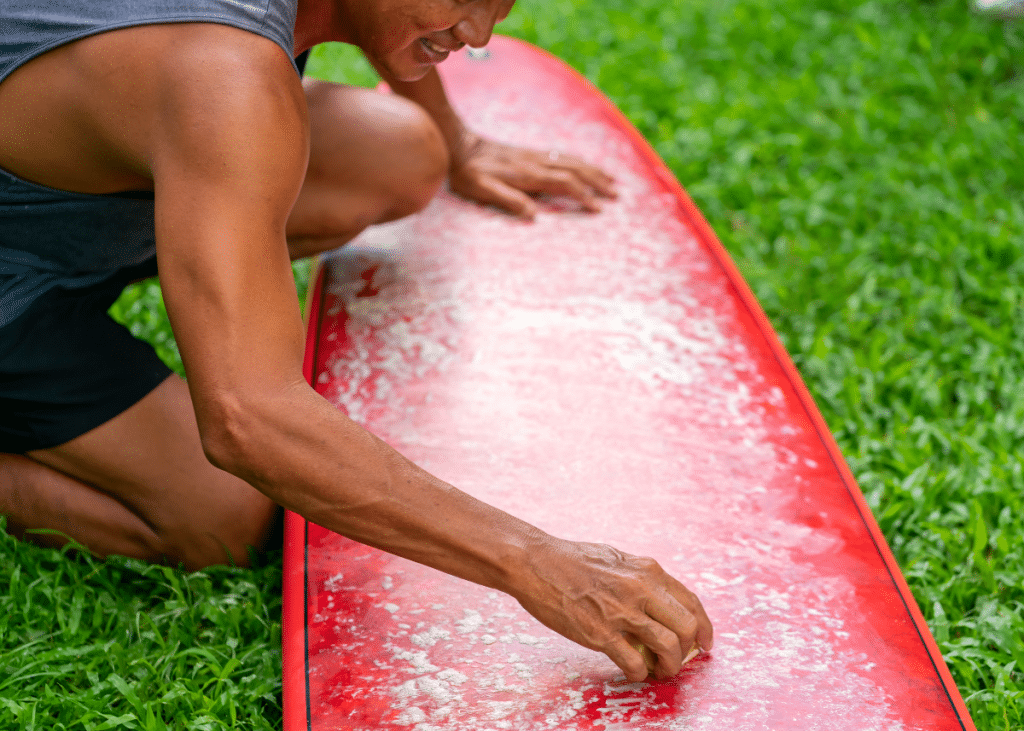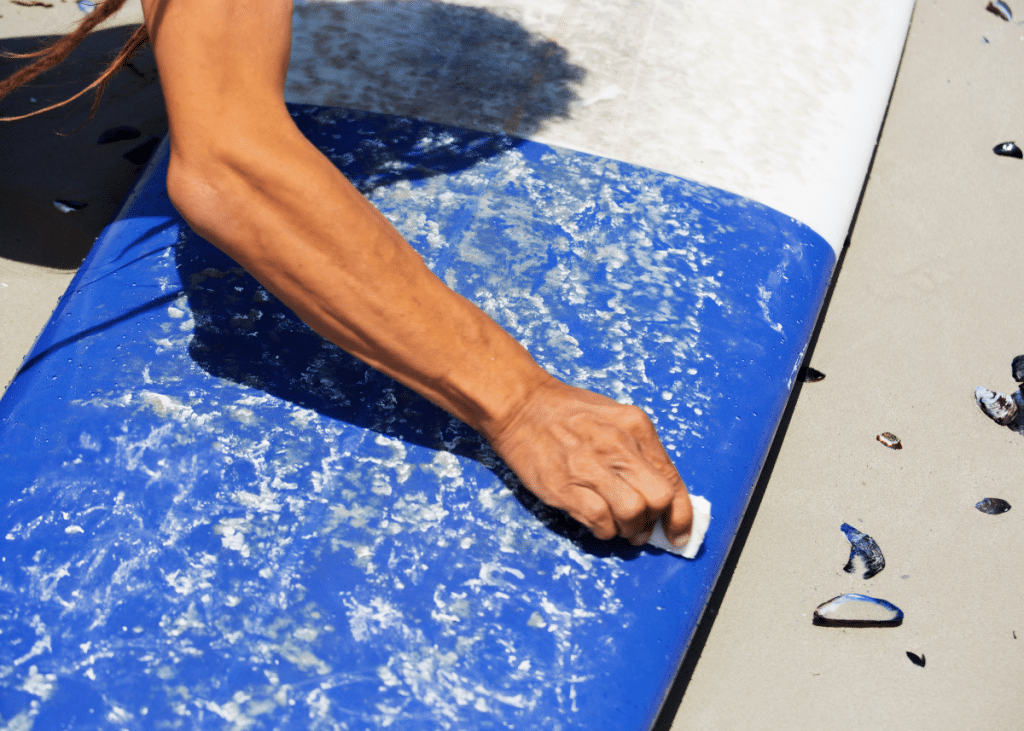Why Do Surfers Wax Their Boards? Surfboard Wax Explained
As a surfer, you know how exciting it can be to catch and ride wave after wave. But did you know how important surfboard wax is? Surfboard wax can mean the difference between catching waves instead of wiping out.
If you’re ready to learn more about the importance of surfboard wax, the different kinds, and how to use it – keep reading!
This post contains affiliate links, which means I receive a small commission, at no extra cost to you, if you make a purchase using this link. Please see my disclosure for more details.
Reasons Why Surfers Wax Their Boards
Waxing your surfboard is an essential part of surfing. It is a simple process that can make a big difference in your overall experience. Here are a few reasons why surfers wax their boards:
Grip and Traction
Surf wax is used to create a rough surface on the deck of your surfboard. This rough surface helps to create friction between your feet and the board, which gives you better grip and traction when you’re paddling or catching and surfing waves. Without wax, your feet will slip and slide all over the entire board, making it difficult to maintain balance and control.
Balance
Waxing your surfboard can also help you maintain balance. When you’re surfing, you need to be able to shift your weight quickly and easily. A well-waxed board will allow you to do this without slipping or losing your footing.
Injury Prevention
By improving grip and balance, waxing your surfboard can also help prevent injuries. When you’re surfing, you’re constantly moving around on the board. Without wax, your feet can slip off the board, causing you to fall and potentially injure yourself. A well-waxed board will give you the grip and traction you need to stay safe and avoid injuries.
Protection
Surf wax can also help protect your board from the elements. The wax creates a barrier between your board and the water, which can help prevent damage from salt, sand, and other debris. It also helps protect the board from the sun’s harmful UV rays, which can cause fading and cracking.

Types of Surf Wax
When it comes to choosing the right surf wax for your board, there are a few things to consider. The kind of surf wax you choose will depend on the temperature of the water you’ll be surfing in, the type of board you have, and your personal preference. Here are the different types of wax:
Temperature-specific Wax
Temperature-specific wax is designed to work best in certain water temperatures. For example, if you’re surfing in cold water, you’ll want to use a cold water wax. If you’re surfing in warmer climates, you’ll want to use a warm water wax. Some waxes are designed to work in a range of temperatures, such as cool water wax.
Tropical Wax
Tropical wax is designed for use in extremely warm water. It’s softer than other types of wax and has a lower melting point, which means it won’t melt off your board in hot water.
Base Coat Wax
Base coat wax is the first layer of wax that you apply to your board. It’s harder than other types of wax and provides a solid base for the top coat of wax to adhere to.
Top Coat Wax
Top coat wax is the final layer of wax that you apply to your board. It’s softer than base coat wax and provides the grip and traction you need while surfing.
Sticky Wax
Sticky wax is a type of wax that’s designed to provide extra grip. It’s ideal for surfers who need extra traction, such as those who surf big waves or do aerial maneuvers.
Traditional Wax
Traditional wax is the most common type of surf wax. It’s a mixture of paraffin and beeswax and provides a good balance of grip and durability.

How to Choose the Right Wax
Choosing the right wax for your surfboard can be a daunting task, especially if you are new to surfing like us! Different waxes are designed for different water temperatures and climates, so it’s important to choose the right one to ensure maximum grip and performance.
The first thing to consider when choosing a surf wax is the water temperature you will be surfing in. If you are surfing in warm water, you will want to use a tropical wax, which is softer and stickier than other waxes. If you are surfing in cool or cold water, you will want to use a harder wax that will provide more grip in colder temperatures.
It’s also important to consider the temperature range of the wax you are using. Some waxes are designed for a specific temperature range, while others are more versatile and can be used in a wider range of temperatures. Be sure to read the label on the wax to determine its temperature range and suitability for your needs.
If you are unsure about which wax to use, ask for advice from experienced surfers or the staff at your local surf shop. They will be able to provide you with recommendations based on the water temperature and climate in your area.
In addition to temperature and climate considerations, you may also want to consider the brand and type of wax you are using. Some surfers prefer natural waxes, while others prefer synthetic waxes. Experiment with different brands and types of wax to find the one that works best for you.

How to Apply Surf Wax
Applying surf wax to your surfboard is an essential step that every surfer must know. Here is a step-by-step guide on how to apply surf wax to your board:
- First, make sure your board is clean and free from any old wax. Use a wax comb to remove any old wax from your board.
- Start by applying a base coat of wax to your board. Use a circular motion to apply the wax in small sections. Make sure to cover the entire deck of the board.
- Once you have applied the base coat, it’s time to apply the topcoat. Use a topcoat wax that is appropriate for the water temperature you will be surfing in. Apply the topcoat wax in the same circular motion as the base coat.
- Some surfers prefer to apply their wax in straight lines or a crosshatch pattern in diagonal lines. Experiment with different techniques to find the one that works best for you.
- As you apply the wax, make sure to use a rubbing motion to ensure the wax is fully embedded in the surface of your board.
- Repeat the process until you have achieved the desired level of grip.
Remember, the key to applying surf wax is to apply it evenly and in the right amount. Too much wax can make your board slippery, while too little wax can make it difficult to grip.
By following these simple steps, you can ensure that your board is properly waxed and ready for your next surf session!

Maintaining Your Surfboard Wax
Now that you know why surfers wax their boards, it’s important to understand how to maintain your wax to ensure optimal performance. Over time, the wax on your board will wear down and become less effective. Therefore, it’s important to know when to reapply wax and how to properly maintain it.
One way to maintain your wax is by using a wax comb. A wax comb is a small plastic tool with ridges that help to evenly distribute the wax on your board. After a few sessions, your wax may become uneven or bumpy, which can affect your grip and performance. Using a wax comb can help to smooth out any bumps and ensure that your wax is evenly distributed.
Another tool that can be helpful for maintaining your wax is a plastic scraper. A plastic scraper can be used to remove any old wax from your board before applying a new layer. This is important because old wax can build up and affect the performance of your board. By removing the old wax, you can ensure that your new layer of wax will be effective.
It’s also important to keep your board clean to ensure that your wax lasts as long as possible. Dirt, sand, and other debris can build up on your board and affect the performance of your wax. To clean your board, simply rinse it off with fresh water after each session.
So, how often should you wax your surfboard? The answer depends on a few factors, such as how often you surf and the water temperature. In general, it’s a good idea to wax your board before each session. If you surf frequently, you may need to reapply wax every few sessions. If you’re surfing in warm water, you may need to apply wax more often than if you’re surfing in cold water.
By maintaining your wax and reapplying it as needed, you can ensure that your board performs at its best. So, grab your wax comb and plastic scraper and get to work!

Environmental Impact of Surf Wax
But wait! Before you head out to your local surf shop, it’s important to consider the impact of surf wax on the environment.
Traditional surf wax is made from paraffin, a petroleum-based product. Paraffin is not biodegradable and can take hundreds of years to break down. When you apply wax to your board, some of it inevitably ends up in the ocean, where it can harm marine life.
Beeswax, coconut oil, and pine resin are all-natural alternatives to paraffin-based surf wax. These ingredients are biodegradable and do not harm marine life. Some surf wax manufacturers also use vegetable oils and essential oils in their wax, making them even more environmentally friendly.
If you want to reduce your environmental impact as a surfer, consider using an eco-friendly surf wax. Look for wax made from natural ingredients and avoid petroleum-based products like paraffin. Some surf wax brands even offer packaging made from recycled materials.
In addition to using eco-friendly surf wax, you can also reduce your impact by properly disposing of old wax. Instead of throwing it in the trash, which can end up in a landfill, try to recycle it or dispose of it in an environmentally friendly way.
By making small changes like using eco-friendly surf wax and properly disposing of old wax, you can reduce your impact on the environment and help protect our oceans and marine life.

Alternatives to Surf Wax
If you’re looking for an alternative to surf wax, you’re in luck. There are several options available that can provide you with the same amount of grip and traction as traditional surf wax.
Traction Pads
Traction pads are an excellent alternative to surf wax. They are made of a soft, grippy material that provides excellent traction for your feet. Traction pads come in a variety of shapes and sizes, so you can find one that fits your board perfectly.
Sticky Wax
Sticky wax is another alternative to surf wax. It is made of a sticky, tacky material that provides excellent grip and traction. Sticky wax is particularly useful for longboards and softtop surfboards, where traditional surf wax can be difficult to apply.
Cork Traction Pad
Cork traction pads are a great alternative to surf wax. They are made of a soft, cork material that provides excellent grip and traction for your feet. Cork traction pads are particularly useful for longboards and shortboards.
Longboard Wax
Longboard wax is a specific type of surf wax that is designed for use on longboards. It is softer and stickier than traditional surf wax, providing greater grip and traction on the larger surface area of a longboard.
Soft Top Surfboards
Soft top surfboards are designed with a soft, foam top that provides excellent grip and traction for your feet. They are a great alternative to traditional surfboards and can be used without any additional grip or traction aids.

Frequently Asked Questions about Surfboard Wax
-
What happens if I don’t wax my surfboard?
If you don’t wax your surfboard, you may slip and lose your balance while paddling or catching waves. This can lead to injuries and a less enjoyable surfing experience. Waxing your surfboard provides grip and traction, which is essential for maintaining control and stability while surfing.
-
What is surfboard wax made of?
Surfboard wax is typically made from a combination of paraffin, beeswax, and other additives. The exact composition varies depending on the brand and type of wax.
-
Where can I buy surf wax?
You can buy surf wax at most surf shops, sporting goods stores, and online retailers. It’s important to choose a wax that is appropriate for the water temperature and conditions you will be surfing in.
-
What are the different types of surf wax?
There are several different types of surf wax, including base coat, top coat, and specialty waxes for different water temperatures and conditions. Some waxes are also designed to be eco-friendly or provide additional benefits like UV protection.
-
How often should I wax my surfboard?
You should wax your surfboard every time you go surfing, or at least once every few sessions. The frequency may vary depending on the type of wax and the water conditions, so it’s important to pay attention to how your board feels and adjust accordingly.
-
Do different surf wax brands affect performance?
Different surf wax brands may have slightly different formulations and textures, which can affect performance. However, the most important factor is choosing a wax that is appropriate for the water temperature and conditions.
-
Can I use candle wax instead of surf wax?
No, you should not use candle wax instead of surf wax. Candle wax is not designed to provide the same level of grip and traction as surf wax, and may actually make your board more slippery.
-
How do I remove old wax from my surfboard?
You can remove old wax from your surfboard using a wax comb, scraper, or solvent. There are also specialized wax removal tools available. It’s important to remove all of the old wax before applying new wax.
-
Can surf wax go bad or expire?
Surf wax can degrade over time, especially if it is exposed to high temperatures or sunlight. However, most waxes have a long shelf life and can last for several years if stored properly. If your wax becomes discolored or has an unusual texture, it may be time to replace it.

Don’t Forget to Wax Your Surfboard!
Waxing your surfboard is an essential part of surfing. It provides grip and traction, which helps you stay on your board while paddling and surfing waves. Waxing also protects your board from the elements and helps prevent injuries.
When it comes to choosing the right wax, it’s important to consider the water temperature and the type of board you have. A hard wax is better for warmer water, while a softer wax is best for colder water. If you have a longboard, you may need more wax than if you have a shortboard.
Remember to wax your board regularly, especially if you surf frequently. A well-waxed board will help you perform better and enjoy your surfing experience more.
Final thoughts: Surf wax is an inexpensive and easy way to improve your surfing performance. It’s also a fun way to personalize your board and express your style. So go ahead and experiment with different surf waxes and see what works best for you. Happy surfing!

Anh
Anh recently retired at the age of 35 and moved to a small surf town in Portugal in 2023. She started surfing as a hobby, but she fell in love with the water sport. She shares her tips and tricks with fellow surfers at Go With the Surf.












